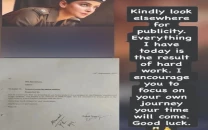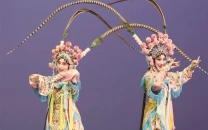For artist Imran Qureshi, all the world’s a canvas
Pakistani artist Imran Qureshi reflects on wider geo-political issues, religious sentiments in latest installations

The installation ‘Garden within a Garden’ in Bradford’s Lister Park pays homage to people in the Indian army who died fighting for the British. PHOTOS: FILE
Through the installation at Truro Cathedral, he reflects on wider geo-political issues and religious sentiments. Qureshi hopes it becomes a stimulus for constructive interfaith debate in the city. “It looks like a polluted, daunting mountain from far away but upon coming closer, one sees flowers on it. Similarly, religious buildings look intimidating from a distance but after going inside, people realise it’s a whole different experience,” Qureshi tells The Express Tribune.

The installation itself will be constructed from 30,000 A1 crumpled, printed sheets carrying rather beautiful images in green. Previously, Qureshi has played with the same concept but in reds, signifying violence, but for him, a religious space called for something inspirational. Currently, his other works in Cornwall are at Newlyn Art Gallery and The Exchange, which will open on July 1. The former showcases new and existing works, reflecting his mastery of the Mughal miniature art. For the latter, he devised an installation where painted imagery spills from large canvasses across walls and floors.
Creative cocktail: Young artists showcase their mettle with a riot of colours
Qureshi’s other undertaking is, ‘Garden Within a Garden’ at Bradford’s Lister Park and City Park — a project that has garnered a great deal of attention. As part of 14-18 NOW, UK’s arts programme for the World War I centenary, artists were commissioned from all over the country. “They wanted representation from our side as well, because our part of the world gave one million soldiers to fight alongside the British Army in World War I. My work pays homage to the people in the Indian army who died fighting for the British.”
The designs have been created with acrylic paints applied directly onto cement for which he’s used a new, darker palette of black and grey in Lister Park. “It is a darker palette because the war was technically for the white. Besides, all our imagery and therefore visual memories of World War I are black and white. The bombing and burning of war also turns everything into a gloomy black,” he says about his choice of colour.
Qureshi ensures his site specific projects make strong dialogues with the architectural environment of the place. “The water channels have been painted black so my work looks like it’s been spilled out of there. Additionally, Mughals had a lot of symmetry in their patterns and the project starts in symmetry but the further you go the more distorted it gets. That is to signify how war affects heritage and culture.” He asserts that in some places it looks like it’s been painted in negative and some in positive. The idea was when people and objects were shifted from the subcontinent, they were taken out of their origins into another context.

The second painting, in City Park is a blue and red circular work with a circumference of 25 feet. “This is more lighthearted and poetic,” he reveals. His show Where The Shadows Are So Deep which opened in February of this year at the Curve, Barbican, London is still on as well. All this is especially remarkable because of the 16th century Mughal technique Qureshi deploys. His miniature design efforts mean that every aspect of the process is meticulous and fascinating.
Published in The Express Tribune, June 30th, 2016.
Like Life & Style on Facebook, follow @ETLifeandStyle on Twitter for the latest in fashion, gossip and entertainment.



















COMMENTS
Comments are moderated and generally will be posted if they are on-topic and not abusive.
For more information, please see our Comments FAQ